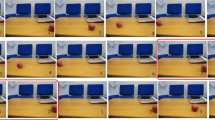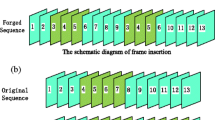Abstract
The extensive availability of software tools and technological advancements have made it possible to alter or modify digital data in today's digital environment. It was fairly simple to properly manipulate video content thanks to the accessibility of inexpensive software products like Adobe Premiere, Magix Vegas, Mokey by Imagineer Systems, and Microsoft Movie Maker. Thanks to these sophisticated video editing programmes, changing the contents of digital videos has become very simple. In order to hide the truth, video editing software is frequently used to copy and paste a section of the frame from one location to another region in the same frame or another frame. One of the most popular techniques for manipulating with videos is region duplication. By examining the spatial and temporal correlations between the frame's pixels, numerous approaches to identify such tampering in digital video sequences have been presented by various researchers. Nevertheless, majority of the algorithms have significant computational cost and low accuracy. In this research, we present a novel region duplication tampering detection method that uses wavelet transform and Euclidean distance to identify intra frame region duplication in a video sequence. The proposed method is assessed using a variety of video sequences where region duplication in frames introduced. Performance of the suggested technique is evaluated based on experimental findings in terms of Precision, Recall, F1, Accuracy, and calculation time. Our experimental results proved that this method is highly suitable for detecting the duplicated regions in the video which is very much useful in forensic applications.















Similar content being viewed by others
References
Ye, Z., **a, M., Yi, R., Zhang, J., Lai, Y.- K., Huang, X., Zhang, G., & Liu, Y.-J. (2022). Audio-driven talking face video generation with dynamic convolution kernels. TMM.
Johnston, P., & Elyan, E. (2019). A review of digital video tampering: From simple editing to full synthesis. Digital Investigation, 29, 67–81.
Sitara, K., & Mehtre, B. M. (2016). Digital video tampering detection: An overview of passive techniques. Digital Investigation, 18, 8–22.
Xu, Z., Hong, Z., Ding, C., Zhu, Z., Han, J., Liu, J., & Ding, E. (2022). Mobile face swap: A lightweight framework for video face swap**. In AAAI.
Singh, G., & Singh, K. (2019). Video frame and region duplication forgery detection based on correlation coefficient and coefficient of variation. Multimedia Tools and Applications, 78, 11527–11562.
Nirmal Jothi, J., & Letitia, S. (2020). Tampering detection using hybrid local and global features in wavelet-transformed space with digital images. Soft Computing, 24, 5427–5443.
Pandey, R. C., Singh, S. K., & Shukla, K. K. (2016). Passive forensicsin image and video using noise features: A review. Digital Investigation, 19, 1–28.
Kaur, H., Saxena, J., & Singh, S. (2015). Simulative comparison of copy-move forgery detection methods for digital images. International Journal of Electronics, Electrical and Computational System, 4, 62–66.
Zitova, B., & Flusser, J. (2003). Image registration methods: A survey. Image and Vision Computing, 21(11), 977–1000.
Alkawaz, M., Sulong, G., Saba, T., & Rehman, A. (2018). Detection of copy–move image forgery based on discrete cosine transform. Neural Computing and Applications, 30(1), 183–192.
Lichao, Su., & Li, C. (2018). A novel passive forgery detection algorithm for video region duplication. Multidimensional Systems and Signal Processing, 29, 1173–1190.
Qadir, G., Yahaya, S., & Ho, A.T. (2012). Surrey university library for forensic analysis (SULFA) of video content. In IET conference on image processing, pp. 1–6.
Rublee, E., Rabaud, V., Konolige, K., & Bradski, G.R. (2011). ORB: An efficient alternative to SIFT or SURF. In ICCV, 11(1), 2564-2571.
Lin, G.S, Chang, J.F., & Chuang, C.H. (2011). Detecting frame duplication based on spatial and temporal analyses. In Proceedings of the 2011 6th international conference on computer science & education (ICCSE), pp. 1396–1399.
Sujatha, G., Hemavathi, D., Sornalakshmi, K., & Sindhu, S. (2021). Video tampering detection using difference-hashing algorithm. In Journal of physics: conference series, p. 1804.
Gan, Y., Yang, J., & Lai, W. (2019). Video object forgery detection algorithm based on VGG-11 convolutional neural network. In 2019 International conference on intelligent computing, automation -and systems (ICICAS), pp. 575–580.
Liu, Y., & Huang, T. (2017). Exposing video inter-frame forgery by Zernike opponent chromaticity moments and coarseness analysi. Multimedia Systems, 23, 223–238.
J Bakas, R Naskar (2018) A digital forensic technique for inter–frame video forgery detection based on 3D CNN. In Information systems security, pp. 304–317
Chen, S., Tan, S., Li, B., & Huang, J. (2016). Automatic detection of object-based forgery in advanced video. IEEE Transactions on Circuits and Systems for Video Technology, 26(11), 2138–2151.
Bidokhti, A., & Ghaemmaghami, S. (2015). Detection of regional copy/move forgery in MPEG videos using optical flow. In 2015 The international symposium on artificial intelligence and signal processing (AISP), pp. 13–17.
Yang, Q., Yu, D., Zhang, Z., Yao, Y., & Chen, L. (2021). Spatiotemporal trident networks: detection and localization of object removal tampering in video passive forensics. IEEE Transactions on Circuits and Systems for Video Technology, 31(10), 4131–4144.
Zhong, J., Pun, C.-M., & Gan, Y. (2020). Dense moment feature index and best match algorithms for video copy-move forgery detection. Information Science, 537, 184–202.
Asikuzzaman, M., & Pickering, M. R. (2018). An overview of digital video watermarking. IEEE Transactions on Circuits and Systems for Video Technology, 28(9), 2131–2153.
Amanipour, V., & Ghaemmaghami, S. (2018). Video-tampering detection and content reconstruction via self-embedding. IEEE Transactions on Instrumentation and Measurement, 67(3), 505–515.
Raveendra, M., & Nagireddy, K. (2022). Tamper video detection and localization using an adaptive segmentation and deep network technique. Journal of Visual Communication and Image Representation, 82, 103401.
Raskar, P. S., & Shah, S. K. (2021). Real time object-based video forgery detection using YOLO (V2). Forensic Science International, 327, 110979.
Mahmood, T., Nawaz, T., Irtaza, A., Ashraf, R., Shah, M., & Mahmood, M. T. (2016). Copy–move forgery detection technique for forensic analysis in digital images. Mathematical Problems in Engineering, 2016, 13.
Wang, X. Y., Liu, Y. N., Huan, X., Wang, P., & Yang, H.-Y. (2018). Robust copy–move forgery detection using quaternion exponent moments. Pattern Analysis and Applications, 21(2), 451–467.
Cozzolino, D., Poggi, G., & Verdoliva, L. (2015). Efficient dense-field copy–move forgery detection. IEEE Transactions Information Forensics Security, 10(11), 2284–2297.
Li, Q., Wang, R., & Xu, D. (2023). A video splicing forgery detection and localization algorithm based on sensor pattern noise. Electronics, 12(6), 1362.
Zhao, J., & Guo, J. (2013). Passive forensics for copy–move forgery using a method based on DCT and SVD. Forensic Science International, 233(1–3), 158–166.
Dixit, R., Naskar, R., & Mishra, S. (2017). Blur invariant copy–move forgery detection technique with improved detection accuracy utilizing SWT-SVD. IET Image Processing, 11(5), 301–309.
Khizear, H., & Qazi, T. (2017). Forgery detection in digital images via discrete wavelet and discrete cosine transforms. Computers and Electrical Engineering, 62, 448–458.
Ardizzone E., Bruno, A., & Mazzola, G. (2010). Copy-move forgery detection via texture description. In Proceedings of the 2nd ACM workshop on Multimedia in forensics, security and intelligence, ACM, pp. 59–64.
Sadeghi, S., Jalab, H. A., Wong, K. S., Uliyan, D., & Dadkhah, S. (2017). Keypoint based authentication and localization of copy–move forgery in digital image. Malaysian Journal of Computer Science, 30(2), 117–133.
Lu, W., Xu, W., & Sheng, Z. (2023). An interpretable image tampering detection approach based on cooperative game. IEEE Transactions on Circuits and Systems for Video Technology, 33(2), 952–962. https://doi.org/10.1109/TCSVT.2022.3204740
Gu, Z., Chen, Y., Yao, T., Ding, S., Li, J., & Ma, L. (2022). Delving into the local: Dynamic inconsistency learning for deepfake video detection. In AAAI.
Calonder, M., Lepetit, V., Strecha, C., & Fua, P. (2010). Brief: Binary robust independent elementary features. In European conference on computer vision (pp. 778–792). Springer.
Bi, X., Pun, C. M., & Yuan, X. C. (2016). Multi-level dense descriptor and hierarchical feature matching for copy–move forgery detection. Information Sciences, 345, 226–242.
Lee, J. C. (2015). Copy-move image forgery detection based on Gabor magnitude. Journal of Visual Communication and Image Representation, 31, 320–334.
Zandi, M., Mahmoudi Aznaveh, A., & Talebpour, A. (2016). Iterative copy-move forgery detection based on a new interest point detector. IEEE Transactions on Information Forensics and Security, 11(11), 2499–2512.
Fadl, S. M., & Semary, N. A. (2017). Robust copy–move forgery revealing in digital images using polar coordinate system. Neuro Computing, 265, 57–65.
Amerini, I., Ballan, L., Caldelli, R., Del Bimbo, A., & Serra, G. (2011). A sift-based forensic method for copy–move attack detection and transformation recovery. IEEE Transactions on Information Forensics and Security, 6(3), 1099–1110.
Tralic, D., Zupancic, I., Grgic, S., & Grgic, M. (2013). CoMoFoD—new database for copy–move forgery detection. In ELMAR, pp. 49–54.
Wang, W., & Farid, H. (2007). Exposing digital forgeries in video by detecting duplication. In Proceedings of the 9th workshop on multimedia and security, ACM, pp. 35–42.
Yavuz, F., Bal, A., & Cukur, H. (2016). An effective detection algorithm for region duplication forgery in digital images. In Optical pattern recognition XXVII, international society for optics and photonics, pp. 9845.
Author information
Authors and Affiliations
Corresponding author
Ethics declarations
Conflict of Interest
The authors declare that they have no conflict of interest.
Human and Animal Rights
This article does not contain any studies with human or animal subjects performed by any of the authors.
Informed Consent
Informed consent was obtained from all individual participants included in the study.
Additional information
Publisher's Note
Springer Nature remains neutral with regard to jurisdictional claims in published maps and institutional affiliations.
Rights and permissions
Springer Nature or its licensor (e.g. a society or other partner) holds exclusive rights to this article under a publishing agreement with the author(s) or other rightsholder(s); author self-archiving of the accepted manuscript version of this article is solely governed by the terms of such publishing agreement and applicable law.
About this article
Cite this article
Jothi, J.N., Nithila, E.E. & Davix, X.A. Region Duplication Tampering Detection and Localization in Digital Video Using Haar Wavelet Transform. Wireless Pers Commun 135, 655–674 (2024). https://doi.org/10.1007/s11277-024-11028-z
Accepted:
Published:
Issue Date:
DOI: https://doi.org/10.1007/s11277-024-11028-z




